Via Sanese
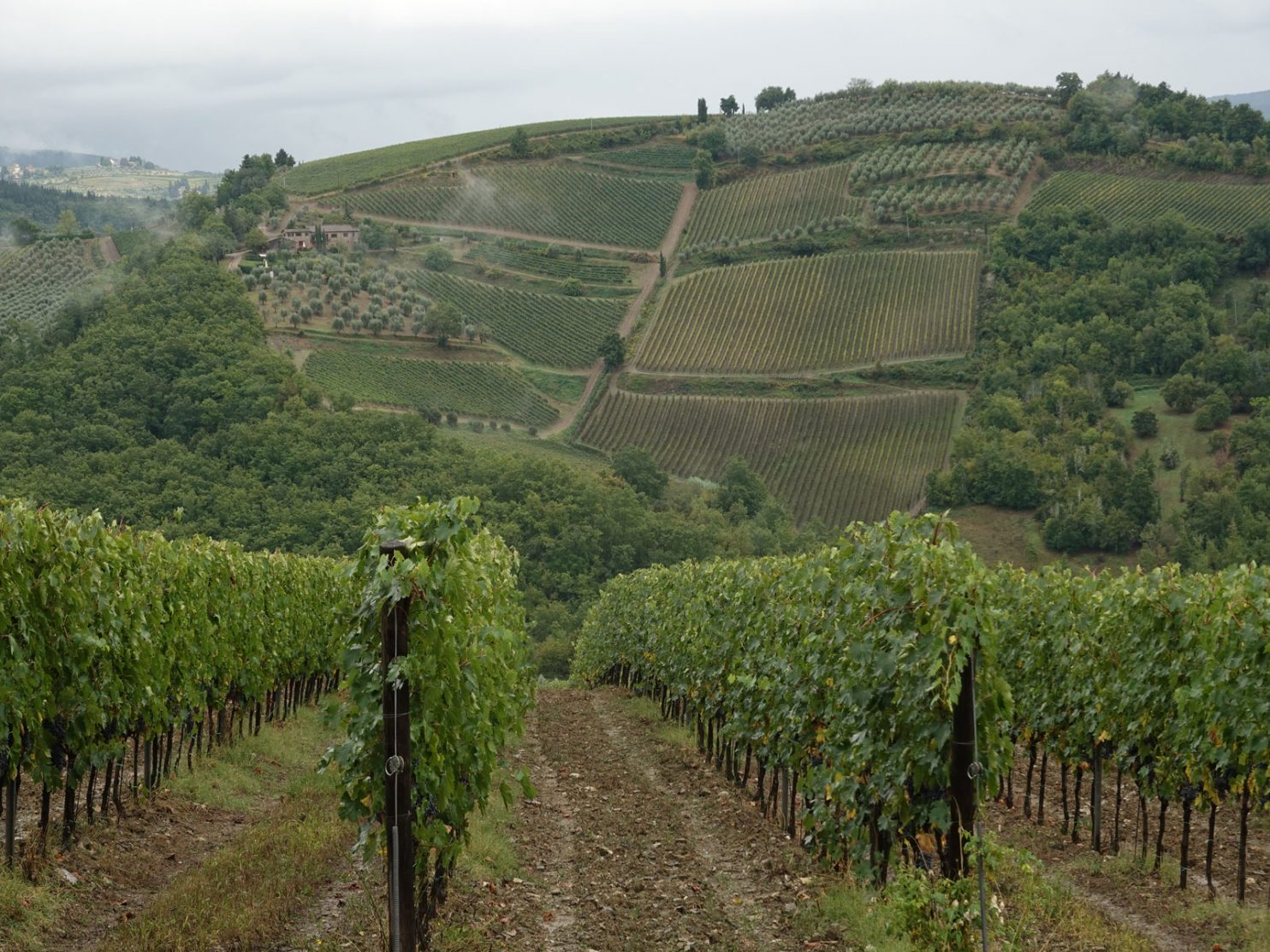
21 Sept. Florence to San Casciano Val di Pesa. 20km. 5,5 hours. 900m up. 630m down. We left Florence via the San Miniato gate around mid morning and at once went up a small deserted traffic free lane which was grassed over. It raised our expectations as to what was to come as we climbed. Behind us views of Florence unfolded like a ruckled red table cloth. There were a couple more lanes before we reached a road after about 2 km.

01. The Ponte Vecchio Bridge is in the centre of Florence and near the start of the Via Sanese Walk

02. Leaving the centre of Florence on the hidden Erta Canina lane on the south side of the bridge near the San Miniato gate.
I was glad of the GPS as the maps alone (and we had 2 at 1:50,000) would have been quite confusing. We walked along the road past some very salubrious villas and more quiet country lanes to the east end of the village of Galluzzo. The country side we passed through was typical of what we expected with small lanes, large hilltop villas surrounded by the tall pencil like Italian Cypress trees, Cupressus sempervirens. Grape vines and olive groves were on each side of the small roads.

03. On the outskirts of Florence where the plush villas quickly give way to a manicured landscape of olive groves just some 2 km from the start
At Galluzzo we decided not to stop for lunch as we had only walked 90 minutes, but to continue under the midday sun for another 90 minutes to Tavermuzze. The series of lanes and roads continued through rolling Tuscan countryside. The route was surprisingly hilly with lots of ups and downs. It was a tranquil peaceful walk through idyllic country side. The heat of the day was intense and we were ready for a break when we reached the small cafe at the start of Tavamuzze for our lunch. A few cold drinks, some filled rolls and a ice cream later we were ready for the second half.

05 The cafe in Tavarmuzze where we stopped for lunch on the first day
It went through the small market town, sleepy in the heat of the afternoon, climbing all the time. We then crossed a bridge over a large road and started up another lane. However it was more of a country road than a lane and quite busy, especially on the Saturday afternoon. Who thought it would be acceptable to direct the Via Sanese route along this road I don’t know, but it was disappointing to walk along it, even if it was an old pilgrimage route. There was at least car or motorbike a minute. It seemed from the map there were good alternatives to the SE via the Florence American Cemetery.
We followed the road for some 5 km, first up through dark deciduous forest before bursting out of it into the rural agricultural vineyards and olives. We could occasionally walk in these fields to get off the road. After a good hour on the road we passed Machiavelli’s Villa near the hamlet of Sant’Andrea in Percussina. There was a restaurant and accommodation cashing in on his popularity nearby. A little after the country road merged with another and became even busier but there were now pavements and fields at the side to avoid the traffic. We passed through a series of small villages and hamlets, including Spedaletto, and then arrived in the larger market town of San Casciano Val di Pesa. It was a delightful town with a quiet main street full of small cafes, artisanal shops and restaurants. We had to walk right through the town to reach our hotel on the south side called Il Ferdino, a Medici era villa some 600 years old. It was better than I expected. San Casciano made up for the 5-6 km walk along the country road. In the evening we went back to the bustling main street for an exceptional dinner at Cafe Nello, which also had great vegetarian food and cheap Chianti Classico wine.
Sept 22. San Casciano Val di Pesa to Villa La Borghetto. 9km. 2,5 hours.260m up. 270m down. The forecast was for a very wet afternoon so despite the fact we only had 9 km to walk we left around 0930. We walked back to the centre of town then along a couple of roads which were closed due to a large and ongoing cycle race. About a km out of town on the east side of it, we veered to the south and followed a delightful series of lanes heading south. It was the highlight of the walk so far as the lanes were rough and stony. Wild blackberries overhung the lanes from the hedgerows each side and clumps of clay, from the damp earth, formed on our boots as we sauntered down. Beyond the hedgerows were vines and olives, less manicured and in fields full of weeds than those nearer Florence in the fields of the large expensive villas. We passed a few more rustic farms and then the lane reached the valley floor at Calzaiolo, a slightly perfunctory village with a large wine factory in an industrial building. There was a simple hotel and trattoria here also.

07. On Day 2 on the small lanes after leaving San Casciano and befire the route descends down to the larger village of Calzaiola
Unfortunately we were back on a country road for a good km again with the hiss of cars passing by every minute at least. It was not for long though, and we soon found our turning and started up the lane to the imposing hilltop Villa Bibbione, we saw earlier in the day from the rough earthy lane. There were grapes beside the lane and as it was deserted we felt empowered enough to pluck a few. They were delicious. After the very grand Villa Bibbione the lane veered SE and passed through olive trees past a few very small hamlets towards Montefiridolfi. About half way along the ridge top we came to Villa Il Borghetto where we had booked in for the night. It was a very short day but the skies were already saturated with rain and a deluge looked imminent.
The trouble was it was just after 1200 and the villa was closed until 1500. So we went to have a look at the Etruscan Tomb nearby. When we returned at 1300 after this side trip with more grapes plucked, we decided to sit on the stone bench of the ancient La Collina church and read our books for one and a half hours. At 1430 their phone answered and we were heartily invited to walk back to the villa and were warmly greeted by Christina. Despite their website information they did not have a restaurant – and we had no car! However Christina made us a simple lunch and promised to make us a simple supper of pasta. The room was a beautiful cottage in the villa’s grounds surrounded by the gardens, a vineyard and olive groves. It was very nice but the lack of food was a surprise. We had just settled in about 1600 when the heavens opened and the forecast rain started to pour which was supposed to last all night.
Sept 23. Villa La Borghetto to San Donato in Poggio. 20 km. 5,5 hours. 700m up. 650m down. We both slept well and long and were ready for the later breakfast of 0830 when the time came. It was a superb breakfast which we ate inside as there was thunder, lightening and heavy rain. We did not set off until 1030 due to the rain and a chat with the hosts. By this time the rain had subsided and the sun was trying to break through. We walked SE along the quiet road for a couple of km past splendid villas to Montefiridolfi where there was a small shop in the beautiful village square, which even under dark skies looked homely. After this village the route continued SE on the very quiet road for another couple of km to a junction after which it took the smallest option which was a gravel track. It passed a couple of very nice villas, one of which was busy with picking grapes with small tractors and cars lined up to transport the harvest up to its adjacent winery. The landscape was still Tuscan but the fields were large and very neatly laid out in multiple rows.

08. Typical Tuscan landscape to the south of Montefiridolphi
The large vineyards on the steeper hills soon came to a halt as we reached San Maria a Macerata, a small hamlet with a beautiful church. After this the landscape was mostly through oak woods, still on the gravel road. As we walked along here the rain returned and we had to don our jackets and cover the rucksacks for the final km to the hamlet of Badia a Passignano where there was an large ancient monastery which dominated the village. A luxury Unimog truck charged past us with “Chainti Food and Wine Safaris” We hoped to get lunch here as our previous host had said there was a restaurant and a few cafes here. However, the restaurant was very expensive and high quality and the cafes were really ordinary restaurants. We found one which would just serve us a cheese and tomato panini. Meanwhile the rain poured down.
We were told that the best way to go now was the alternative route through more woods on quiet roads, and the official way via the town of Sambuca was not that great, so we heeded the advice. We dropped into the oak woods again and then climbed up towards Poggio al Vento, but did not go there and passed to the east of this hamlet. It was really pouring rain now with waves washing down the road. Luckily it only lasted for half an hour. The route now veered south along a gravel track past some very nice farms and guesthouses as it reached Rignana. The sun started to fight though in places and suddenly parts of distant hills burst into golden light surrounded by dull grey. Soon the golden light was in the fields and woods around us with smelt of drying humid earth. Quickly the grey was banished and we were in near constant sun. We could see San Donato, some 5 km away, across the valley now.

09. On Day 3 by Rignana and after the rain had passed
We dropped down the hillside into the Pesa Valley with the track getting rougher and rougher and also smaller until it was only passable with a small tractor. The were a couple of farms down here but they looked semi derelict and the fields were overgrown. The stream at the bottom was very small but it was in lush beech woods. From the map it looked like there was a short cut to San Donato and we took it. However, it was a false path, now completely overgrown, and possibly across private land, so we had to retrace our steps with half an hour wasted. Back at the bridge again we started the long climb up from the valley floor. Again there was a lot of abandoned land and a few derelict houses here which seemed surprising given the close proximity to the next estate called Montecchio on the edge of San Donato, which was in immaculate condition. We reached San Donato around 1730 and met the agent of the apartment we had hired for the night. It was very chintzy and a bit fuzzy for our wet clothing and muddy boots. A hour later we were clean, clothes washed and off to eat in the large village. There was an old quarter with small streets and a rich square with a large town hall, and there was a great pizzeria in front of it. The forecast for the next days was more settled so hopefully that was the end of the rain.

10. The splendid Villa Montecchio on the edge of the small medieval town of San Donato in Poggia
Sept 24. San Donato in Poggia to Castellina in Chianti. 17km. 5 hours. 900m up. 720m down. We had breakfast in a greengrocers which doubled as a cafe in the high street. It was superb and they made us a roll for a packed lunch also. The weather was good at last as we made our way through the village and onto the country road going south. It was not too busy but it was still a bit stressful and humiliating to follow it for the two km to out turn off. I am sure there were alternatives to this road walk on the west side. The two km took us past vineyards and wine tasting villas reeking of middle class.
After the turn off the character of the walk changed entirely. We followed a series of small roads, which were often bullied by encroaching hedgerows, for about 3 hours. It took us past a few farms, too rustic to be villas really, which were almost hidden in the forest. There were no vineyards here in the oak woods and the land looked too rocky and untamed for them. What little agriculture there was seemed to be small holdings of lavender terraces. Some were newly wrenched from the forest and in other places and some were abandoned, with the forest reclaiming them. The farms and houses here were few and far between, perhaps one a km. Occasionally we got some views across the treetops and over the valleys surrounding the hill to distant hilltop villages each with its tower. Towards the end of the forest walk the path became very small and convoluted and we often wondered if we had lost it, especially around some derelict farms. We frequently saw deer on the tracks and lanes and from the signs I was sure we were walking through a protected area. At the end of this section we walked up a long track past the near deserted Cerchiaio farmhouse to a country road. From here there was very difficult section through woods and it seemed the path had vanished just below Pietrafitta. It was largely a holiday home complex and an old church. I suspect the owners of the holiday complex might have destroyed the path to frustrate walkers.

11. Heading into the oak woods after leaving San Donato on Day 4.
There was a small restaurant nearby and we stopped for a drink and ice cream in the hot afternoon sun. It was the hottest spell of the walk and it made us work. After cooling off we walked along a 2-3 km track in the forest beside the road with occasional great views. We made the mistake of making a shortcut across one side of a square and found ourselves on the road again and it was a bushwhack to get back onto the route again. It then went through a very small hamlet called Casa Landi before crossing a lane on a grassed-over track to reach the north end of Castellina in Chianti. It was perhaps the most charming and interesting of all the towns we had passed through but also the most touristy, and certainly more so than San Casciano, our other favourite. We checked into a prebooked hotel in the town centre and went through the usual chores of washing clothes and doing the blog before going out for the evening.
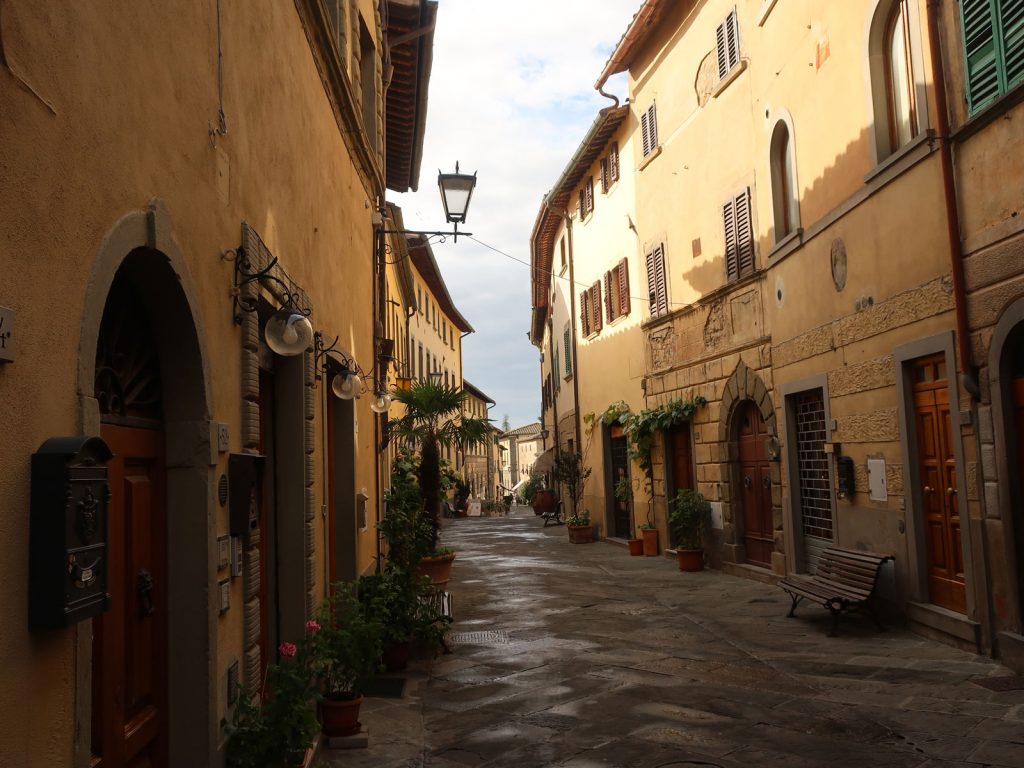
13. The main street of Castellina in Chianti was medieval in appearance with passages and lanes coming off it
Sept 25. Castellina in Chianti to Siena. 27km. 7,5 hours. 960m up. 1260m down. We left Castellina after a visit to the COOP to buy bread, cheese and tomatoes for lunch, as there did not appear to be any cafes en route. We finally made it out of the charming town by 0930 for our long final day. The route went to the SW of town on a very convoluted series of paths. However it kept us off the larger country road above and showed us some countryside. After a good half hour the path seemed to go into an overgrown bramble-covered thicket, so we abandoned it and headed up to the road anyway, having saved a km walk on it.

14. The Cinta Senese pigs are a heritage breed of pig unique to Tuscany and we passed some enclosures with them in just south of Castellina
Soon afterwards we headed up to the east on a track. There were lots of “private property”, “keep out” and “no entry due to foot and mouth” notices about and I doubted the route, but we continued as both maps and the GPS track from the official body directed us along this track to Fonteruli and there seemed to be little alternative. Some ½ km up the 3 km track we passed a field full of large Cinta Senese pigs. They looked like saddle backs. They were semi free range with perhaps 50 in a large stony muddy field, a few with limps. As we were watching them an old BMW came up the track with a lady returning from her morning shop and returning to Casamonti. She stopped and told us it was private property and there was no way through and that the council had made a mistake routing this ancient path through here. I suspected she did not want walkers there and in a “Get off my Land” way had taken the council notices down herself. I was not going to be deterred by her bluster so said we would continue and she drove off after a polite chat. The track continued past her land with many other pig enclosures, but this time in the oak woods, until it got to another xenophobic villa called Tarmonti, who again had “no entry” signs up, but we ignored it and went over the cattle grid. Immediately afterwards we turned off the larger track and followed a rough small track through the oak woods for a few km. There were fences everywhere and no signs of the Via Sanese route which had obviously been removed. At last we got to the larger country road near Forterutoli and could relax more.
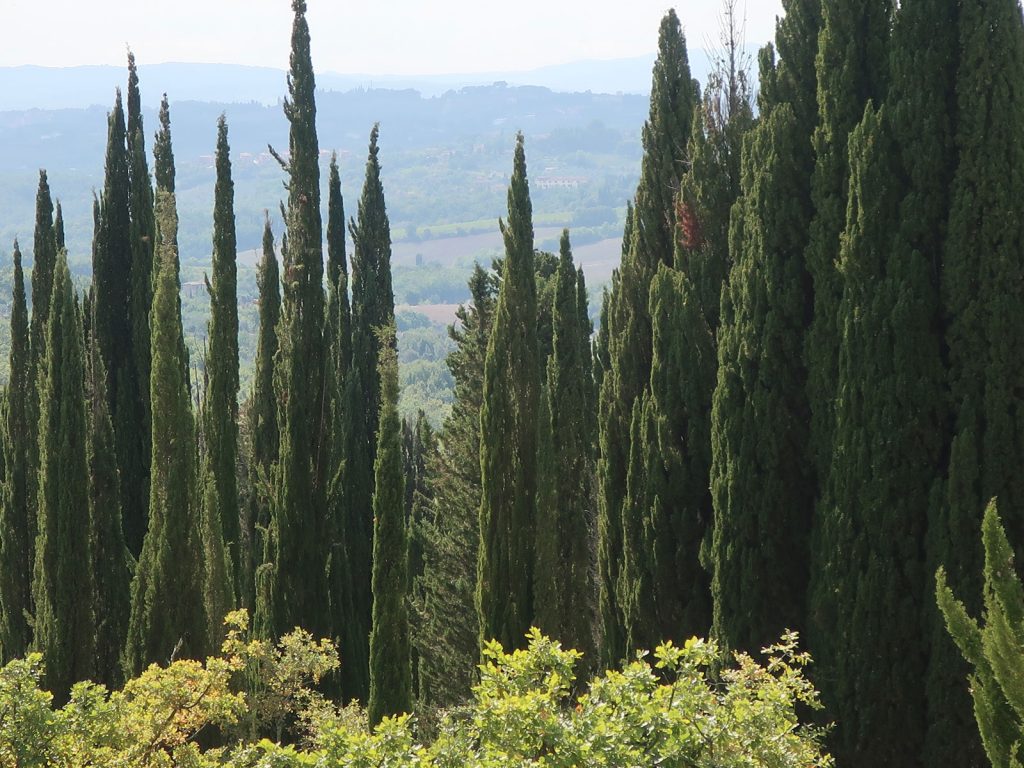
15. Between the village of Fonterutoli and Villa Casafrassi we passed through some oak woods and then burst into this grove of Italian Cyprus; Cupressus sempervirens
The route crossed the road and went through a small wood, crossed the road again and then descended to Fonterutoli. It was a very picturesque place. The was a large house here and I expect the village was built up around it and to serve it and the estate. The village was quaint and beautifully preserved. We passed through and crossed the road again and climbed once more into the oak woods which were much more welcoming. From the top we started a long descent down a rough lane lined with Italian Cypresses. The day was warming up now as we passed a large villa, Villa Casafrassi, which was converted into holiday homes and a guesthouse. The dapper owner was very welcoming as we walked down his drive to a wall under the shade of some olive trees, with a great view over the woods of the open valley. We sat here and had lunch as it was about 3 hours from Castellina.
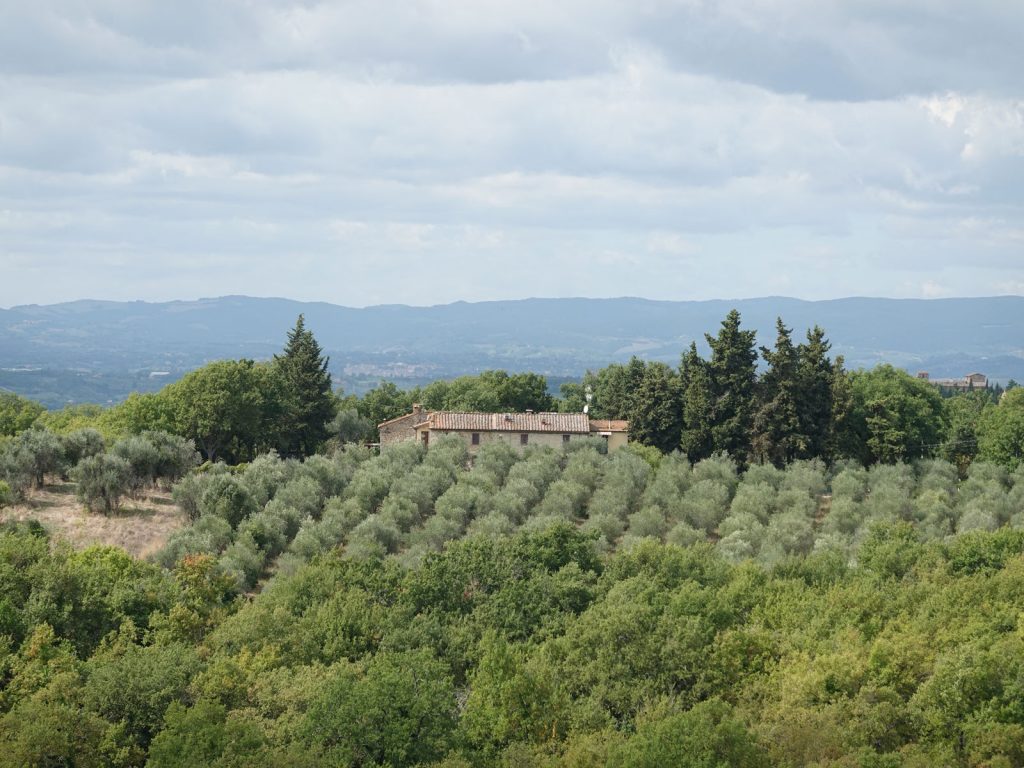
16. A small rural olive grove on a small holding near Villa Casafrassi
After lunch we continued out descent down a grassy track in the forest and into a larger vineyard on the north side of Quercegrossa. Again this vineyard seemed welcoming and the Via Sanese signs were obvious and went along the access tracks for the fields. The fields were in the middle of a harvest and there were trailers laden with grapes being pulled up to the winery.

18. The grapes of the Casalino Frattoria, just north of Quercegrossa where ripe and were being harvested as we passed by
We did not go into Quercegrossa but skirted round the NW and then west side of it climbing up to a ridge. Here the land was much more open and it looked like it was kept for crops or hay. For the first time we saw a large flock of sheep grazing in one of the fields. It was a lovely ridgetop walk for a good hour. The route then descended to stables at La Staggia, and then climbed to an imposing hilltop fortified church at Basciono. It looked like the structure had been turned into private residences now.
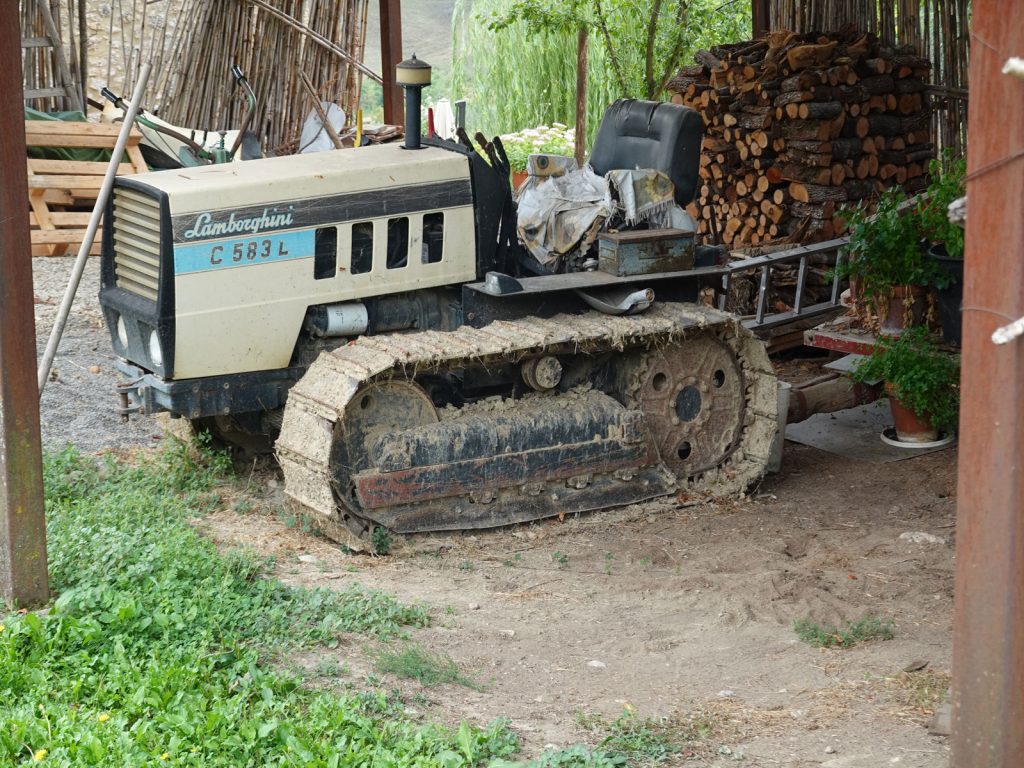
20. For those who posing is not enough Lamborghini also make tractors, as this one near La Staggia stables
After Basciono the path dropped down a lane, passed under a large road and railway line and then passed up a gentle valley before climbing more steeply to the suburb of Uopini. We had been walking for 3 hours again so we had our second lunch here in a small park. It was recommenced to take a bus from here to Siena centre but that would have spoiled the walk. It was only some 5 km to the centre and walking it seemed very reasonable. Except for the first km all was on a pavement. Siena does not really seem to have an ugly industrial belt around it so much of the walk was through an interesting urbanscape.
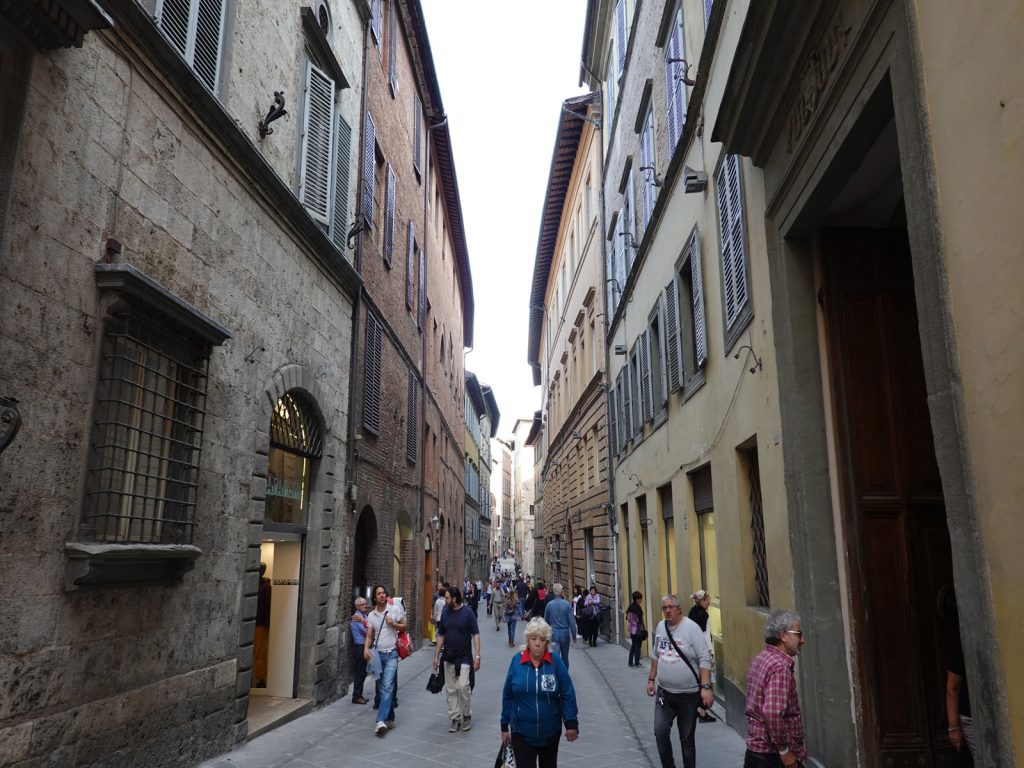
21. Inside the city gates of the medieval city of Siena and heading down the old streets to the main square, the Piazza del Campo.
With about 2 km to go we passed through a large gate in the ancient city walls and then followed a street which became more and more enchanting as we closed in on the city square. At last after some 27 km we walked down a side passage and into the clam-shell shaped square forming a natural amphitheatre with the town hall and it’s impressive tower centre stage. We sat in one of the cafes around the periphery of the square and had a celebratory drink and ice cream before heading to the nearby apartment we had rented for the night. Siena was a beautiful city, perhaps better preserved and less ostentatious that Florence. It was also a bit quieter and although quiet touristic not as vulgarly so as Florence had become.

22. The end of the 5 day trek is Siena’s magnificent Piazza del Campo square. It over 800 years old and hosts the Palio di Siena twice each summer which is a 90 second horse race with 10 locals from different city wards competing.
The Via Sanese from Florence to Siena started quite poorly and the first day from Florence to San Casciano was disappointing with virtually all of it on tarmac. It am sure there could be an alternative to the second half, which was on a larger country road. Our second day was short and I know we would have been better off continuing to the small, but charming, village of Montefiridolfi rather than being marooned at an outlying villa. However, the last three days redeemed the first two and were much more rural and mostly on small lanes and farm tracks. The three towns we stayed in, San Casciano, San Donato and Castellino were all charming and had we stayed at Montefiridolfi instead of the outlying villa I am sure it would have been equally charming. While It was not a tour for mountain aficionados it had its charms and was a good way to see Tuscany at a slow pace. It is a short and easy cultural walk which can probably be done through much of the autumn, winter and spring months.